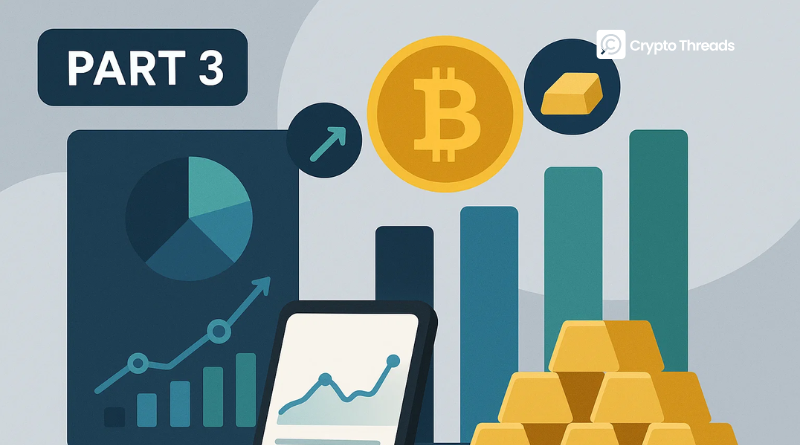Optimizing a Cryptocurrency Portfolio with Gold: A Data-Driven Approach (Part 3)
Introduction: The Quest for Balanced Crypto Portfolios
In the previous installments of this series, “Portfolio Management: A Beginner’s Guide to Building and Optimizing Your Investments (Part 1)” and “Understanding Risk and Return in Portfolio Management (Part 2)” we established the foundational principles of portfolio construction, asset allocation, and the critical interplay between risk and return. The world of cryptocurrency investing, while offering tantalizing potential for high returns, is notoriously volatile. This inherent volatility presents a significant challenge for investors seeking to harness crypto’s growth potential without exposing their portfolios to undue risk.
This article, Part 3, delves into a specific strategy for mitigating this risk: combining a high-growth, high-risk asset like Bitcoin with a traditional store of value, Gold. We will analyze a data-driven approach, leveraging a detailed portfolio backtest report from Portfolio Visualizer covering the period from January 2015 to May 2025. This analysis aims to demonstrate how strategic optimization can potentially lead to superior risk-adjusted returns compared to traditional benchmarks or holding volatile assets in isolation. The core of this strategy revolves around finding an optimal asset mix that maximizes the Sharpe Ratio, a key indicator of return per unit of risk.
Understanding Key Assets in the Optimized Portfolio
To appreciate the optimization strategy, it’s essential to understand the individual characteristics of the assets involved, based on their historical performance within the analyzed timeframe (Jan 2015 – May 2025).
Bitcoin (BTC): The High-Growth Engine
Bitcoin (BTC), a decentralized peer-to-peer digital currency introduced in 2009 by the pseudonymous Satoshi Nakamoto, operates on a Proof-of-Work (PoW) consensus mechanism and is the pioneering cryptocurrency. It is known for its potential for significant price appreciation but also for its extreme volatility.
Key features based on historical data (Jan 2015 – May 2025, from Portfolio Visualizer):
- Compound Annual Growth Rate (CAGR): 74.33%
- Standard Deviation (Volatility): 74.08%
- Best Year Return: 1,368.90%
- Worst Year Return: -73.56%
- Maximum Drawdown: -75.57%
- Sharpe Ratio (standalone): 1.08
- Sortino Ratio (standalone): 2.28
These figures highlight Bitcoin’s capacity for extraordinary growth alongside substantial risk.
Gold (Represented by Gold Price Index): The Stability Anchor
Gold, a precious metal historically revered as a store of value and a hedge against inflation and economic uncertainty, is often included in investment portfolios for its perceived stability and low correlation with other asset classes. In this analysis, it’s represented by the Gold Price Index.
Key features based on historical data (Jan 2015 – May 2025, from Portfolio Visualizer):
- Compound Annual Growth Rate (CAGR): 10.07%
- Standard Deviation (Volatility): 13.91%
- Best Year Return: 25.62%
- Worst Year Return: -12.11%
- Maximum Drawdown: -16.59%
- Sharpe Ratio (standalone): 0.63
- Sortino Ratio (standalone): 1.14
Gold offers much more modest returns compared to Bitcoin but with significantly lower volatility, making it a potential stabilizing force in a diversified portfolio.
The Optimization Strategy: Maximizing the Sharpe Ratio
The core objective of the portfolio optimization discussed in this article is to Maximize the Sharpe Ratio.
Sharpe Ratio, a measure of risk-adjusted performance of the portfolio, is calculated by dividing the mean monthly excess return of the portfolio over the risk-free rate by the standard deviation of excess return, with the displayed value annualized. A higher Sharpe Ratio indicates a better return for the amount of risk taken.
Based on this optimization goal, using historical returns from January 2015 to May 2025 and monthly rebalancing, the recommended allocation was:
Gold: 73.90%
Bitcoin: 26.10%
This allocation seeks to harness Bitcoin’s high growth potential while using Gold’s lower volatility and different market behavior to temper overall portfolio risk.
Performance Analysis of the Optimized Gold-BTC Portfolio (January 2015 – May 2025)
Based on the historical data collected, we continue to compare this optimized portfolio with a traditional investment benchmark, the Vanguard 500 Index Investor.
Overall Returns and Growth: Outpacing Traditional Benchmarks
An initial balance of $10,000 invested in January 2015 in the optimized Gold−BTC portfolio would have grown to $158,422 by May 2025. This represents a Compound Annual Growth Rate (CAGR) of 30.37%.
For comparison, the Vanguard 500 has grown by just $34,133, representing a CAGR of 12.51%.
The optimized portfolio significantly outweighed the traditional stock market benchmark over this period. The best year for the optimized portfolio yields a return of 145.79%, while its worst year saw a decline of -24.99%.
Volatility and Risk Metrics: A Calculated Trade-off
While delivering higher returns, the optimized Gold-BTC portfolio also exhibited higher volatility:
- Standard Deviation: 22.40% for the Gold-BTC portfolio, compared to 15.31% for the Vanguard 500 Index. This indicates greater fluctuations in the Gold-BTC portfolio’s value.
- Maximum Drawdown: -26.42% for the Gold-BTC portfolio. This occurred from January 2018 to November 2018, with the portfolio taking until June 2019 (1 year and 6 months underwater period) to recover to its previous peak. The Vanguard 500 Index experienced a maximum drawdown of -23.95% during the period.
- Sortino Ratio: This metric, which focuses on downside volatility, was 2.80 for the Gold-BTC portfolio, significantly higher than the Vanguard 500’s 1.14.
Sortino Ratio, a measure of risk-adjusted return which is a modification of the Sharpe Ratio, differentiates harmful volatility from total overall volatility by using the asset’s standard deviation of negative portfolio returns—downside deviation—instead of the total standard deviation of portfolio returns. A higher Sortino ratio indicates a better return for the amount of downside risk taken.
- Downside Deviation (monthly): 2.75% for the Gold-BTC portfolio.
Downside deviation, a measure of downside risk, focuses on returns that fall below a minimum threshold or a user-specified target return; it quantifies the volatility of these “bad” returns.
Despite higher overall volatility, the superior Sortino Ratio suggests the Gold-BTC portfolio was more efficient in generating returns relative to its downside risk compared to the benchmark.
The Power of Low Correlation in Diversification
A key factor contributing to the portfolio’s risk-adjusted performance is the low correlation between Gold and Bitcoin.
The monthly correlation between the Gold and Bitcoin from January 2015 to May 2025 was 0.06.
Correlation, a statistical measure of how two securities move in relation to each other, ranges from -1 to +1. A correlation of +1 implies they move perfectly in sync, -1 perfectly opposite, and 0 implies no linear relationship.
This very low positive correlation (close to zero) means that the price movements of Gold and Bitcoin are largely independent. When one asset performs poorly, the other does not necessarily follow suit, which helps to smooth out overall portfolio returns and reduce risk – a core principle of diversification.
Alpha and Beta: Measuring Outperformance and Market Sensitivity
- Beta (*): The optimized Gold-BTC portfolio had a Beta of 0.46 relative to the Vanguard 500 Index Investor (Risk and Return Metrics).
Beta (*), a measure of systematic risk, indicates the volatility of a portfolio in comparison to the market as a whole (represented by a benchmark); a beta greater than 1 suggests more volatility than the market, while less than 1 suggests less volatility. A beta of 0.46 means the Gold-BTC portfolio was, on average, less volatile than the Vanguard 500 Index in response to broad market movements, despite its higher internal standard deviation. - Alpha (annualized): The portfolio generated an impressive annualized Alpha of 23.19%.
Alpha (annualized), a measure of the active return on an investment, indicates the performance of an investment compared to a suitable benchmark index. A positive alpha of 23.19% suggests the portfolio significantly outperformed its expected return given its beta. - R-Squared: The R-Squared value was only 9.98%.
R-Squared, a statistical measure that represents the percentage of a portfolio’s movements that can be explained by movements in its benchmark index, ranges from 0 to 100%. An R-Squared of 9.98% indicates that less than 10% of the Gold-BTC portfolio’s price movements were attributable to the movements of the Vanguard 500 Index, further emphasizing its diversification benefits and independent return drivers.
Building and Managing Your Crypto-Gold Portfolio
Translating this historical analysis into a practical investment strategy requires careful planning and ongoing management.
Step-by-Step Implementation Guide
- Define Investment Goals and Risk Tolerance: As discussed in Part 1 and 2, clearly define your financial objectives, time horizon, and how much risk you are comfortable taking. The analyzed portfolio had a CAGR of 30.37% with a max drawdown of -26.42%; assess if such figures align with your personal profile.
- Determine Asset Allocation: Based on the optimization (or your adjusted version), decide on the percentage allocation. The Maximum Sharpe Ratio model suggests 73.90% Gold and 26.10% Bitcoin.
- Select Investment Platforms:
- For Gold: Consider Gold ETFs (Exchange Traded Funds) like GLD (SPDR Gold Shares) or IAU (iShares Gold Trust), which can be bought and sold through standard brokerage accounts. Understanding what an ETF is and how it works is beneficial. You can also learn about tokens that represent Gold like $XAUT, $PAXG, etc.
- For Bitcoin: Utilize reputable cryptocurrency exchanges such as Coinbase, Binance, or Kraken. Ensure you understand security measures like two-factor authentication and consider cold storage for larger holdings.
- Invest Gradually (Dollar-Cost Averaging): Especially for volatile assets like Bitcoin, implementing a dollar-cost averaging (DCA) strategy can mitigate the risk of investing a lump sum at a market peak. This involves investing a fixed amount of money at regular intervals.
- Initial Investment Example: Following the report’s $10,000 initial balance:
- Gold (73.90%): $7,390
- Bitcoin (26.10%): $2,610
The Critical Role of Rebalancing
The analyzed model employed monthly rebalancing.
Rebalancing, the process of realigning the weightings of a portfolio of assets, involves periodically buying or selling assets in a portfolio to maintain an original desired level of asset allocation or risk.
Over time, due to differing performances, the allocation percentages will drift. For example, if Bitcoin significantly outperforms Gold, its weighting in the portfolio will increase, potentially exposing the portfolio to more risk than initially intended. Monthly rebalancing back to the 73.90%/26.10% split ensures the portfolio stays aligned with its optimized risk-return profile.
Monitoring Key Performance and Risk Indicators
Regularly monitor your portfolio’s performance against your goals and the metrics discussed:
- Overall Return (CAGR): Is it meeting your expectations?
- Sharpe Ratio and Sortino Ratio: How is the risk-adjusted return holding up?
- Volatility (Standard Deviation): Are fluctuations within your comfort zone?
- Drawdowns: Track the depth and duration of any significant dips.
- Correlation: While harder for individual investors to track precisely, be aware of major market shifts that might alter historical correlations.
Advanced Risk Considerations for the Optimized Portfolio
The Risk and Return Metrics above provides several advanced risk metrics that offer deeper insights:
- Value at Risk (VaR): The historical Value-at-Risk (5%) for the Gold-BTC portfolio was 6.84%.
Value at Risk (VaR), a statistic that quantifies the extent of possible financial loss within a firm, portfolio, or position over a specific time frame at a given confidence level. For example, a VaR of 6.84% at a 5% confidence level for one month implies there is a 5% chance the portfolio could lose at least 6.84% in the next month, based on historical data. - Conditional Value at Risk (CVaR): The Conditional Value-at-Risk (5%) was 8.03%.
Conditional Value at Risk (CVaR), also known as Expected Shortfall (ES), quantifies the expected loss once the VaR breakpoint has been breached. It calculates the average loss in the tail of the distribution beyond the VaR point. So, if the 5% VaR of 6.84% is breached, the average expected loss would be 8.03%. - Skewness and Kurtosis:
- Skewness: 0.53. Skewness, a measure of the asymmetry of the probability distribution of a real-valued random variable about its mean. Positive skewness indicates a distribution with an asymmetric tail extending toward more positive values.
- Excess Kurtosis: -0.24. Excess Kurtosis, a measure of whether the data are heavy-tailed or light-tailed relative to a normal distribution. Negative excess kurtosis (platykurtic) indicates a distribution with lighter tails and a flatter peak than a normal distribution.
- Performance in Different Market Conditions (Up/Down Markets):
- In Up Markets (when the Vanguard 500 Index was positive), the Gold-BTC portfolio outperformed the benchmark in 44% of the occurrences.
- In Down Markets (when the Vanguard 500 Index was negative), the Gold-BTC portfolio outperformed the benchmark (i.e., lost less or gained) in 75% of the occurrences. This highlights the portfolio’s defensive characteristics, likely due to Gold’s influence and the low correlation. The average active return during down markets was +4.53%.
Conclusion: Strategic Diversification for the Modern Investor
The analysis of a Gold-Bitcoin portfolio, optimized for the Sharpe Ratio from January 2015 to May 2025, demonstrates a compelling case for strategic diversification incorporating cryptocurrencies. The optimized portfolio achieved a remarkable 30.37% CAGR, significantly outpacing the Vanguard 500 Index, albeit with higher standard deviation. However, its superior Sortino Ratio, strong positive Alpha, and defensive characteristics during down markets suggest efficient risk management.
The low correlation between Gold and Bitcoin was a key driver of these results, underscoring the benefits of combining assets with different risk-return profiles. While past performance is not indicative of future results, this data-driven approach provides a valuable framework for investors looking to integrate high-growth digital assets into their portfolios responsibly. Effective portfolio management, diligent monitoring, and disciplined rebalancing are crucial for navigating the complexities of modern investment markets and striving for long-term financial success.



